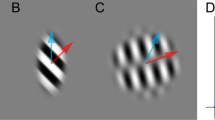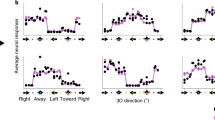Abstract
The neuronal responsiveness to three-dimensional (3D) motion in cat posteromedial lateral suprasylvian (PMLS) cortex was studied using a computer-controlled, stereoscopic 3D graphic display capable of reproducing the major visual cues for natural 3D motion, including motion disparity, size, texture, and shading changes. The animals were anesthetized with nitrous oxide supplemented with alphaxalone, and paralysis prevented eye movement. Systematic investigation of neuronal responsiveness to 3D motions in 26 different directions revealed that more than half of the PMLS cells were selectively responsive to approaching (AP cells, 112 of 271) or recessive motion (RC cells, 64 of 271). The remaining cells were selectively responsive to frontoparallel motion (FP cells, 49 of 271) or nonselectively responsive to motion in multiple directions (NS cells, 46 of 271). The dependency on these visual cues was investigated as a reduction in the response amplitude or the response selectivity for the removal of a single cue from the motion stimuli containing the full visual cues. The AP and RC cells showed a strong dependency on the motion disparity cue, moderate dependency on the size cue, and weak dependency on the texture and shading cues. The FP cells showed no dependency on those visual cues. The cue dependency analysis indicated the existence of nonlinear interactions between those visual cues. Comparison of the responses to a combination of the motion disparity and size cues with the summed responses to each of the individual cues revealed that the responses to the combined cues are roughly predicted as a linear sum between the preferred responses. This comparison also showed nonlinear summation between the nonpreferred responses, i.e., responses to the combined cues were smaller than the summed responses. A similar quasilinear summation of the preferred responses between the two eyes and a nonlinear summation of the nonpreferred responses were found in the AP and RC cells for the motion disparity stimulus. All of these observations indicate that quasilinear and nonlinear interactions of the responses to various stimulus elements underlie the 3D motion responsiveness of the PMLS cells.
Similar content being viewed by others
Author information
Authors and Affiliations
Additional information
Received: 6 January 1998 / Accepted: 23 April 1998
Rights and permissions
About this article
Cite this article
Akase, E., Inokawa, H. & Toyama, K. Neuronal responsiveness to three-dimensional motion in cat posteromedial lateral suprasylvian cortex. Exp Brain Res 122, 214–226 (1998). https://doi.org/10.1007/s002210050509
Issue Date:
DOI: https://doi.org/10.1007/s002210050509




